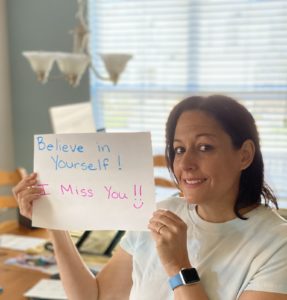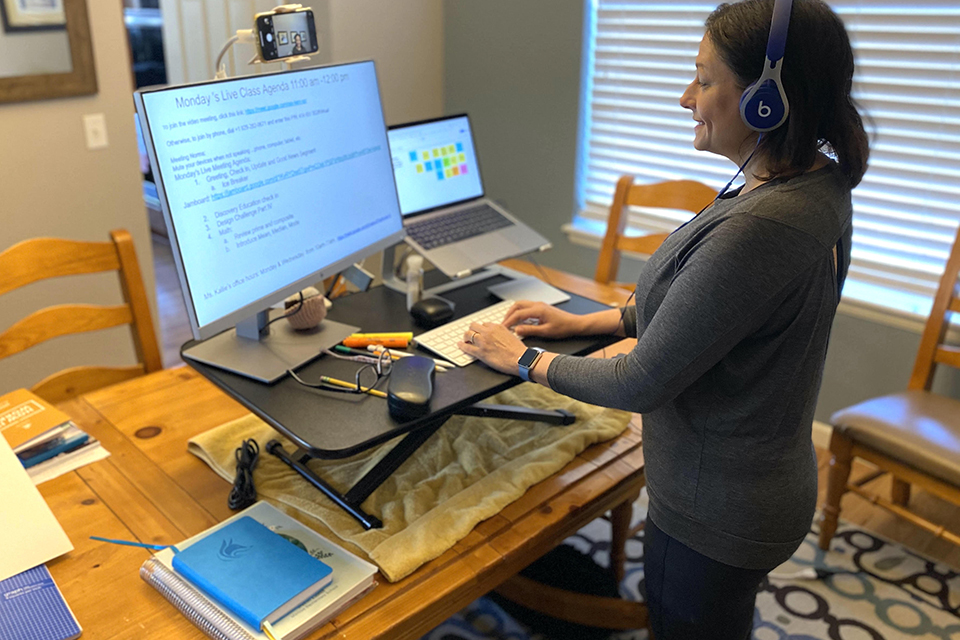With summer in full swing, Kaiser Permanente Thriving Schools recognizes the teachers, staff, and district leaders who have sustained learning and health during such a challenging time. The following story is just one example of the care and dedication of so many educators. We hope it provides insight and hope for the future of schools.
How do you channel the fears, anxieties, dreams, yearnings, and motivation of a room full of fifth graders into a radically different learning environment — overnight?
Like many teachers and school staff, Lorraine Elias found herself navigating uncertain terrain during these months of the COVID-19 pandemic. A fifth-grade teacher at Monroe Elementary School in Loveland, Colorado, Elias had to make a major shift in March to virtual teaching as schools across the country closed their doors and families sheltered in place to stop the spread of the disease.
For Elias, a virtual classroom was not an unfamiliar space. She had experience teaching kids in a virtual environment through her previous role at a hybrid alternative school.
“The challenge was how to have kids who are used to a traditional school buy in to this new experience, keeping their attention, keeping them motivated,” she explained. “I needed to assure them that they would be all right, that they would be counted.”
Within days of the school closures, Elias reached out to each of her 19 students, inviting them to help her create their new shared virtual classroom together. She called them to find out how they were doing and what technology they needed to stay connected. With the support of her school principal, the district, and her instructional partner, she worked to ensure every student had access to a laptop and Wi-Fi. Within days, she set up Google Meet classroom sessions with a regular schedule and office hours.
“The students were huge leaders as well,” says Elias. “In the beginning, if there were students I couldn’t reach as easily because of language barriers or them not answering the phone, another student would step up and reach out to that student and help to connect us.”
Elias’ classroom had always been a safe, respectful, and engaging environment, and she worked hard to transition those qualities to the new shared virtual classroom. She describes some of the ways she’s done this:
 When the class logs on, I have cheerful and fun music playing. It usually brings a smile to their faces. They could also request songs to start our class. That is a way to get students to have ownership during live class meetings.
When the class logs on, I have cheerful and fun music playing. It usually brings a smile to their faces. They could also request songs to start our class. That is a way to get students to have ownership during live class meetings.
We always have a greeting and a check-in, and that often includes compliments for one another. We also start out with a “Good News” segment, to cultivate a positive environment. For example, in one class I featured this piece of good news. I told students they can send me a piece of “Good News” to feature, if they find one.
I want the kids to think critically about everything that is going on around them. We work to define the problems they see in the world and start to think about how we might address them. While the students often want to jump to solutions, I try to focus them on how to feel empathy. We discuss who we are trying to help and what they need.
We will eventually end with a solution step. While we look to generate ideas for making a positive global impact, we often end with: “What small thing can we do at home that will help with this problem?”
Elias has always included a strong social-emotional learning component in her curriculum, whether she’s teaching language arts or math or science. She also tries to tune in to her students, to connect with them and know when they are having good days and bad days.
Adds Elias, “I have a grid view during the Google Meet so I can see all of them at once. At first, some of them were hiding their faces or not turning their cameras on. I’d gently tell them, ‘I want to see your face, so I can understand how you’re feeling and whether you don’t understand something.’ In the class, we are a family. I want them to know this is a trusted space.”
On Thursday, May 21, the school held its “moving up” ceremony where the students officially graduated to the next grade level. Reflecting on the past few months of teaching and learning with these students, Elias has very warm and positive feelings about it all.
“This whole experience with this classroom of students has really changed me. They lift me up. If it wasn’t for my school where everybody helps each other, we couldn’t have pulled through. That’s what makes everything work.”




